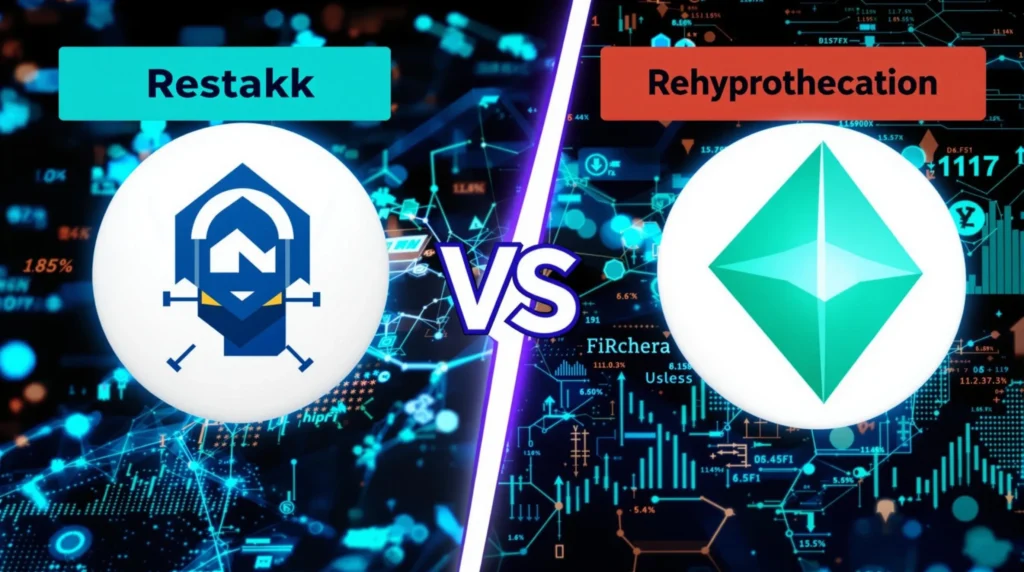Unlocking Restaking: Debunking the Rehypothecation Myth in Crypto

In the fast-evolving world of cryptocurrency, new concepts emerge constantly, often borrowing terms from traditional finance. Restaking, a buzzword gaining traction, is sometimes likened to ‘rehypothecation,’ a term carrying a negative connotation due to its association with financial crises. But are they truly the same? Let’s dive deep into the nuances of restaking and rehypothecation to understand their similarities and, more importantly, their profound differences in the crypto landscape.
Decoding Restaking: A Powerful DeFi Strategy
Restaking is a mechanism primarily within the Decentralized Finance (DeFi) ecosystem, particularly relevant in networks like Ethereum. It builds upon the concept of staking, where users lock up their cryptocurrency to support the network’s operations and earn rewards. Restaking takes this a step further, allowing users to leverage their staked assets for additional purposes, often to secure other networks or services. This opens up exciting possibilities for optimizing returns and enhancing network security.
Think of it like this: you’ve already secured the Ethereum network by staking your ETH. Now, with restaking, you can use that same staked ETH to also contribute to the security of another blockchain or a decentralized application (dApp). In return for this added security provision, you earn extra rewards on top of your initial staking gains. It’s a powerful way to amplify the utility and profitability of staked assets within the crypto space.
Key Benefits of Restaking:
- Enhanced Capital Efficiency: Restaking allows users to earn multiple streams of rewards from a single staked asset, maximizing capital utilization.
- Increased Security for Emerging Networks: Newer blockchains or dApps can bootstrap their security by leveraging the staked assets of established networks through restaking mechanisms.
- Potential for Higher Yields: By participating in restaking, users can potentially earn significantly higher yields compared to traditional staking alone.
- Contribution to a More Interconnected Crypto Ecosystem: Restaking fosters greater interoperability and collaboration between different blockchain networks.
Rehypothecation: A Risky Practice in Traditional Finance
Rehypothecation, on the other hand, is a practice prevalent in traditional finance, particularly within prime brokerage services. It involves the reuse of collateral pledged by clients, often without their explicit consent or full understanding of the risks involved. Imagine a scenario where you deposit assets as collateral for a loan. Rehypothecation allows the lender to then use your collateral as their own, potentially lending it out again and again. This layering of claims on the same asset can create systemic risk and amplify losses during market downturns.
The 2008 financial crisis highlighted the dangers of excessive rehypothecation. The collapse of Lehman Brothers, for instance, was exacerbated by the complex web of rehypothecated assets, making it difficult to trace ownership and unwind positions. This example serves as a stark reminder of the inherent risks associated with this practice in traditional finance.
Why Rehypothecation is Risky:
- Increased Systemic Risk: The cascading effect of rehypothecation can amplify market shocks and contribute to systemic instability.
- Counterparty Risk: Clients may face significant losses if the institutions rehypothecating their assets fail.
- Opacity and Complexity: The intricate chains of rehypothecation can make it difficult to understand the true extent of risk exposure.
- Potential for Loss of Collateral: In extreme scenarios, clients could lose their collateral if it becomes entangled in the insolvency of multiple institutions.
Restaking vs. Rehypothecation: Spotting the Critical Differences in Cryptocurrency Risk
While both restaking and rehypothecation involve leveraging assets, the context, mechanisms, and risk profiles are fundamentally different. Equating them is a simplification that overlooks crucial distinctions. Let’s break down the key differences to understand why comparing restaking and rehypothecation as ‘the same but different’ is misleading, and why focusing on the ‘different’ is paramount for understanding cryptocurrency risk.
| Feature | Restaking | Rehypothecation |
|---|---|---|
| Context | Decentralized Finance (DeFi), Blockchain Networks | Traditional Finance, Prime Brokerage |
| Purpose | Enhance network security, increase capital efficiency, earn additional rewards | Generate profits for financial institutions by leveraging client collateral |
| Transparency | Typically transparent and auditable on the blockchain | Often opaque and complex, lacking transparency |
| Consent | Requires explicit user consent and participation | Can occur without explicit client consent or full understanding |
| Risk Profile | Smart contract risk, protocol risk, slashing risk (clearly defined and often quantifiable) | Systemic risk, counterparty risk, opacity risk (less transparent and potentially catastrophic) |
| Control | Users retain more control over their assets and participation | Users have limited control and visibility over how their collateral is used |
Navigating Cryptocurrency Risk in Restaking: What to Consider?
While restaking is not rehypothecation, it’s essential to acknowledge that it is not without risks. Understanding and mitigating these risks is crucial for anyone considering participating in restaking within the DeFi space. Here are some key aspects to consider when evaluating cryptocurrency risk in restaking:
- Smart Contract Risk: Restaking protocols rely on smart contracts, which are susceptible to bugs or vulnerabilities that could lead to loss of funds. Thoroughly audit and research protocols before participating.
- Protocol Risk: The underlying restaking protocol itself might have design flaws or economic vulnerabilities that could impact users. Understand the protocol’s mechanics and governance.
- Slashing Risk: In some restaking mechanisms, validators can be penalized (slashed) for malicious or negligent behavior, potentially leading to a loss of staked assets. Be aware of slashing conditions.
- Liquidity Risk: Restaked assets might be subject to lock-up periods, and exiting positions quickly might not always be possible, leading to liquidity risk.
- Complexity: Restaking can be complex, involving multiple protocols and interactions. Ensure you fully understand the process and associated risks before engaging.
The Future of Restaking and DeFi: A Powerful Force
Despite the inherent risks associated with any financial activity, restaking presents a significant advancement in DeFi. It offers a path towards greater capital efficiency, enhanced network security, and potentially higher yields for crypto users. As the DeFi ecosystem matures, restaking is poised to play an increasingly important role in shaping the future of blockchain technology and Ethereum staking in particular.
It’s crucial to approach restaking with informed awareness, understanding the nuances and differentiating it from risky practices like rehypothecation. By focusing on due diligence, risk management, and continuous learning, users can navigate the exciting opportunities presented by restaking while mitigating potential downsides. The power of restaking lies in its ability to unlock new levels of utility and value within the crypto space, but like any powerful tool, it must be wielded with knowledge and caution.
Conclusion: Embrace Restaking’s Potential, Acknowledge the Nuances
In conclusion, while the comparison between restaking and rehypothecation might seem superficially valid due to the concept of asset leverage, it’s a dangerous oversimplification. Restaking, within the context of DeFi, is a fundamentally different mechanism with distinct goals, risk profiles, and levels of transparency compared to rehypothecation in traditional finance. Understanding these differences is paramount for anyone venturing into the world of DeFi and seeking to leverage the innovative possibilities of restaking. Embrace the potential of restaking, but always prioritize education and responsible risk assessment to navigate this exciting frontier of cryptocurrency.










